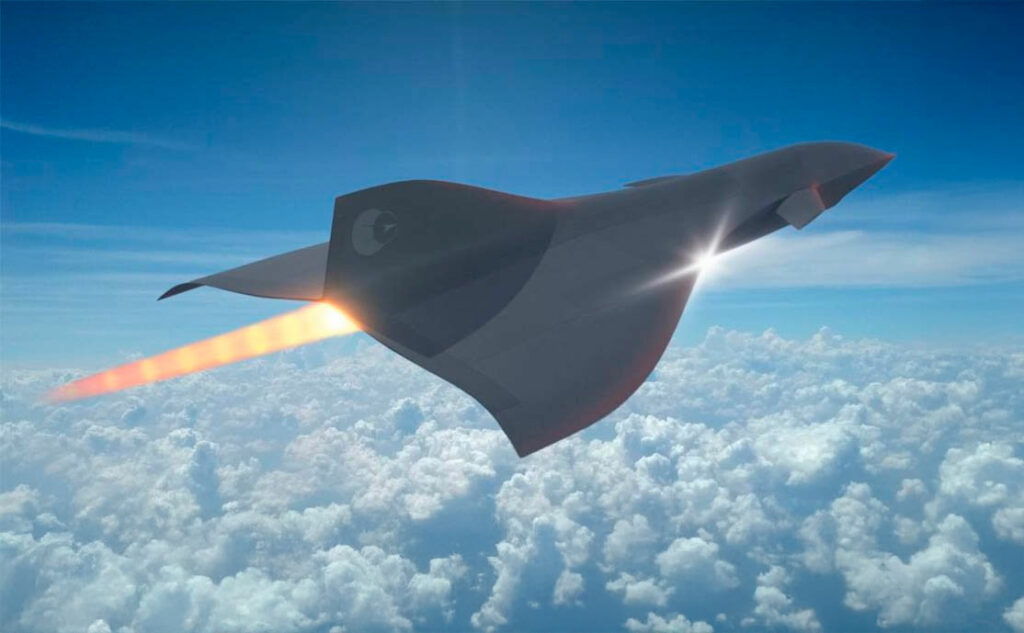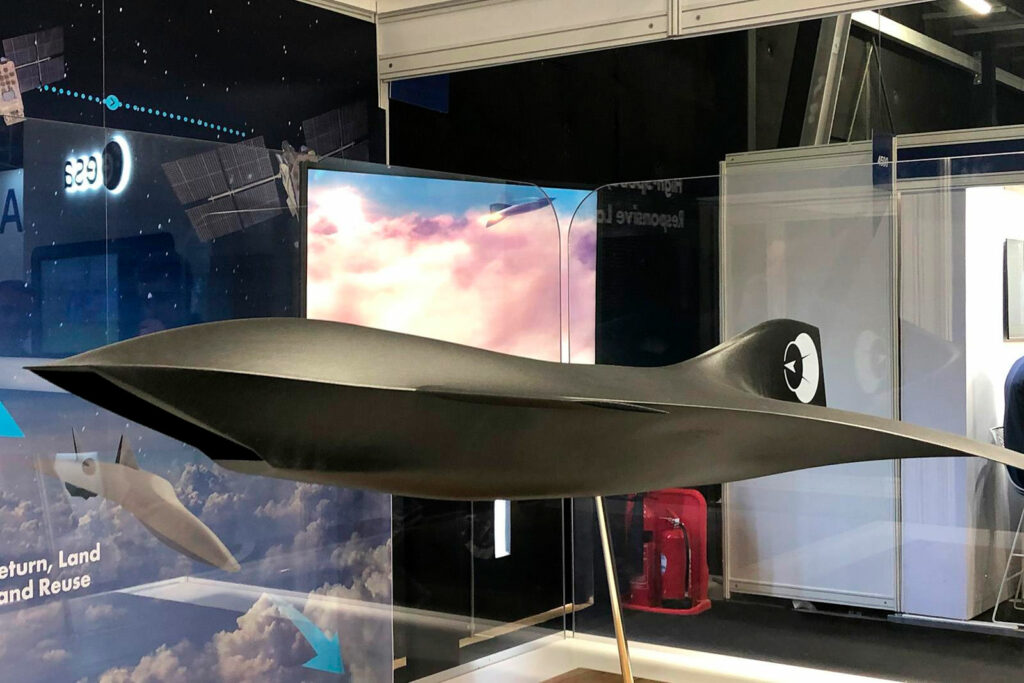Reusable unmanned hypersonic demonstrator for RAF with Mach 5 speed, Reaction Engines-Rolls-Royce propulsion, BWB layout, and ramjet system.
The HVX (Hypersonic air Vehicle, Experimental) is an unmanned hypersonic demonstrator aircraft under development for the Royal Air Force (RAF). Designed as a reusable platform, HVX is expected to reach speeds of Mach 5 or approximately 3,836 mph (6,173 km/h) and operate below 300,000 feet (91,440 meters). The vehicle employs a blended wing-body (BWB) aerodynamic design with a low-drag profile optimized for high-speed flight. Propulsion is based on a hybrid scheme developed by Reaction Engines and Rolls-Royce, combining a gas turbine, a precooler, and a ramjet. The aircraft is intended for rapid-response missions, with potential weaponization. Its configuration includes a rectangular air intake under the nose, a central vertical stabilizer, and a focus on high-speed stability and thermal resistance. The HVX was first publicly presented at Farnborough Airshow 2022. Its objective is to test key technologies required for future hypersonic systems and provide a foundation for operational hypersonic platforms.
History of the development of the HVX
The HVX program was initiated in response to the rapid international progress in hypersonic vehicle development during the late 2010s and early 2020s. Following multiple successful tests of hypersonic weapons by China (DF-ZF), Russia (Avangard and Kinzhal), and the United States (AGM-183A ARRW), the British Ministry of Defence recognized the strategic disadvantage of lacking indigenous hypersonic capabilities. As early as 2020, discussions began within the UK’s Defence Science and Technology Laboratory (Dstl) to support a domestic hypersonic platform for technological and operational validation.
In 2022, the concept of the HVX was unveiled at the Farnborough International Airshow. The design was presented as a reusable, unmanned, Mach 5-capable platform for the Royal Air Force. The project was positioned as a technology demonstrator, not an operational aircraft, but a tool to validate propulsion systems, thermal protection, aerodynamics, and mission architecture related to hypersonic operations. The driving goal was to test air-breathing hypersonic propulsion at scale, using hybrid cycles and integrated thermal management.
The development effort is led by Reaction Engines Ltd, known for its SABRE engine precooler technology, in collaboration with Rolls-Royce, a major supplier of advanced turbine systems for aerospace applications. The goal is to leverage the precooler system—which can reduce the temperature of incoming air from over 1,000°C to ambient temperatures in less than 1/20th of a second—to support engine components during hypersonic flight.
In parallel, the RAF and Dstl explored how the HVX could inform future combat air systems, including integration with the Team Tempest 6th-generation fighter program. The HVX platform would also allow RAF to evaluate autonomous control at extreme velocities, dynamic mission routing, and thermal fatigue behavior in reusable components.
The aircraft’s first flight is anticipated no earlier than 2032, pending prototype testing and engine integration. The RAF has outlined milestones for bench testing, wind tunnel validation, and full-flight envelope expansion. If successful, the HVX could evolve into a launch platform for hypersonic reconnaissance, strike, or missile delivery systems.
No NATO reporting name has yet been publicly associated with the HVX, which remains a UK-only designation for now. The program is positioned to ensure that the UK retains sovereign knowledge over high-speed flight, materials science, and thermal management systems—domains critical for aerospace defense autonomy in the coming decades.

Design of the HVX
The HVX features a blended wing-body (BWB) configuration, merging fuselage and wings into a continuous aerodynamic surface. This design reduces wave drag and enhances stability at hypersonic speeds. The forward fuselage integrates a rectangular air intake beneath the nose, feeding air to the propulsion system during initial acceleration. The vertical stabilizer is mounted at the rear of the fuselage to manage directional stability at high velocity.
Dimensions of the aircraft are not publicly confirmed, but extrapolations based on testbed scale models suggest a wingspan of approximately 18 feet (5.5 meters) and a length of 28 feet (8.5 meters). Materials include carbon-carbon composites, ceramic matrix composites (CMCs), and titanium alloys, chosen for their heat resistance and strength-to-weight ratio. The leading edges are likely protected with reinforced carbon-carbon, similar to what was used on the Space Shuttle.
Thermal protection is a major focus. The HVX is designed to withstand temperatures exceeding 1,650°F (900°C) during cruise, especially at stagnation points such as the nose and wing leading edges. Internal systems are thermally isolated using heat-resistant insulation and radiative coatings to maintain avionics and payload functionality.
The propulsion design incorporates an air-breathing hybrid engine. During takeoff and subsonic climb, the aircraft uses a gas turbine supplied by Rolls-Royce. Once reaching appropriate speed and altitude, the precooler system by Reaction Engines rapidly cools incoming air, enabling transition to a ramjet phase. In this mode, the engine compresses high-speed air without moving parts and combusts it with onboard fuel. This allows sustained acceleration beyond Mach 4.5.
Fuel is expected to be JP-7 or a similar high-flashpoint kerosene, commonly used in supersonic and hypersonic vehicles due to its thermal stability. Fuel also acts as a heat sink in regenerative cooling circuits throughout the airframe.
Aerodynamically, the BWB shape minimizes pressure drag and facilitates distributed load bearing. However, control at subsonic speeds is complex due to reduced aerodynamic surfaces. Stability augmentation through flight control computers is essential. The design also imposes limitations on internal payload volume due to the narrow fuselage cross-section. Integration of weapons, if pursued, would likely rely on conformal external bays or recessed payload doors to minimize drag.
Overall, the HVX design prioritizes thermal survivability, reusability, and aerodynamic efficiency, but imposes constraints in terms of maneuverability and versatility at low speed.
Performance of the HVX
The HVX is expected to reach speeds of Mach 5, equivalent to approximately 3,836 mph (6,173 km/h) at cruising altitude. The operational ceiling is projected below 300,000 feet (91,440 meters). Exact performance metrics remain classified, but modeling based on known propulsion technologies and mission requirements provides indicative parameters.
Propulsion is built around a hybrid system combining a Rolls-Royce turbojet and a ramjet augmented by Reaction Engines’ precooler system. The precooler reduces the temperature of incoming hypersonic airflow from 1,000°C to 100°C almost instantaneously, preventing structural overheating and allowing combustion stability.
The thrust output during ramjet operation is estimated at over 50 kN (11,200 lbf), based on similar-scale demonstrators. The transition point from turbojet to ramjet operation occurs around Mach 2.5, at an altitude of 65,000 feet (19,812 meters). Acceleration from subsonic to hypersonic regimes is completed within 4 minutes under typical flight conditions.
Range is a function of thermal limits, drag, and fuel efficiency. The HVX is expected to achieve a one-way range of 1,000–1,500 nautical miles (1,850–2,778 km), depending on speed profile and payload configuration. The return flight would require a separate launch if the vehicle is not equipped for loiter or reverse flight. Loiter time is negligible due to high fuel burn rates in hypersonic cruise.
Compared to other experimental platforms, such as the U.S. X-51 Waverider (top speed Mach 5.1, range 500 nautical miles), the HVX offers greater reusability and expanded flight envelope. It also contrasts with the Russian Zircon missile, which is single-use and fully autonomous. The U.S. DARPA HAWC project similarly employs air-breathing engines, but it lacks the HVX’s design focus on reusability and modular testing.
Thermal fatigue, material ablation, and control at high dynamic pressures are limiting factors in repeated operations. Surface temperatures can exceed 1,800°F (980°C), necessitating refurbishment cycles between flights.
The aircraft is not designed for sustained low-speed operation and requires high-speed launch assistance or boosted takeoff using expendable rocket stages or air launch. However, this design supports cost-effective test repetition, allowing faster development cycles for future hypersonic systems.
Overall, the HVX’s performance envelope is optimized for short-duration, high-speed test runs with emphasis on system validation rather than endurance or combat maneuvering.

Variants of the HVX
The HVX program is currently centered around a single baseline configuration, but development proposals include multiple experimental variants tailored to specific research objectives.
- HVX-T (Testbed): The initial variant, focused on propulsion validation and high-speed aerodynamics. It lacks any weapon bays or mission systems. The focus is on thermal measurement, control algorithms, and structural fatigue under Mach 5 conditions. Internal instrumentation includes real-time telemetry, strain gauges, and surface temperature sensors.
- HVX-R (Reconnaissance): A proposed surveillance-focused configuration. This version would integrate high-resolution infrared and multispectral sensors for high-altitude overflight missions. The emphasis is on stealth shaping and reduced radar cross-section. A small ventral payload bay could house electronic intelligence packages or synthetic aperture radar (SAR) modules.
- HVX-W (Weaponized): A theoretical variant for long-term development. It would include two conformal weapons bays, each capable of carrying a light hypersonic glide vehicle (HGV) or directed-energy payload. Integration would require significant changes to airframe balance and thermal shielding.
Each variant is based on the same core airframe, but with modular systems added or removed as needed. Variants share propulsion architecture and thermal protection systems. No production models have been finalized as of 2025, and variant development is contingent on successful flight testing and funding beyond the demonstrator stage.
Military missions of the HVX
Although the HVX is not designed as a frontline operational asset, its architecture and modularity allow for simulation of future military mission profiles. If adapted beyond its demonstrator role, it could fulfill a range of high-speed strategic tasks.
The primary military value lies in high-speed reconnaissance. A potential HVX-R variant would perform overflight missions with infrared, radar, and electronic surveillance payloads, penetrating air defenses through speed rather than stealth. With speeds exceeding Mach 5, defensive systems such as S-400 or Patriot PAC-3 would face reduced engagement windows, limiting interception probability.
Weaponization is under conceptual evaluation. The HVX-W could deliver hypersonic glide vehicles (HGVs) or precision-guided bombs. However, integration would demand new thermal shielding for payload bays and control stability under asymmetric load conditions. A more feasible configuration involves use as a launch platform for high-speed missiles or boost-glide test units.
Armament plans remain theoretical. No missiles or bombs are integrated into current prototypes. However, the aircraft could conceptually carry lightweight scramjet missiles or directed-energy payloads for future threat engagement.
Competing systems include the X-51A, DARPA HAWC, and Zircon. Unlike HVX, these platforms are single-use or limited-reuse, while HVX focuses on repeatable missions for cost-effective testing and concept exploration.
No foreign military has adopted the HVX. It remains a UK-specific program. Its closest collaborative potential lies in joint development with NATO partners, especially the United States under existing technology sharing agreements. Integration into the Team Tempest ecosystem may further its relevance as a high-speed auxiliary or ISR node.
As of 2025, HVX remains in pre-flight development. It has not been replaced, nor canceled. If abandoned, it may be succeeded by a more advanced derivative or integrated into the Future Combat Air System (FCAS) framework. Its experimental nature makes its long-term operational future uncertain, but its mission simulations provide valuable input for future doctrine.
Back to the experimental aircraft section.